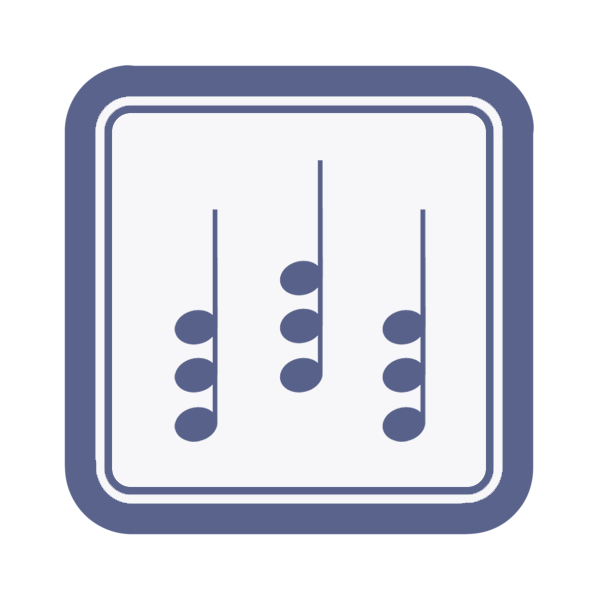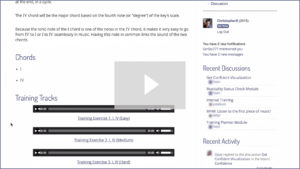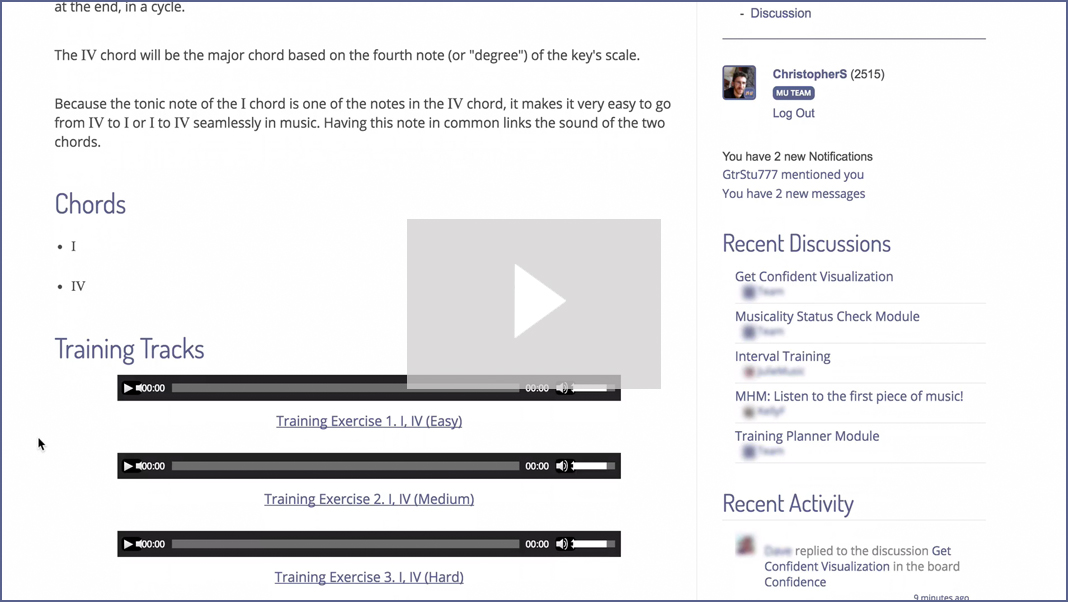Play Chords By Ear Mini-Course
Lesson 3: Start recognising chord progressions today
This lesson is based on the Chord Progression Recognition module from Musical U.
Not yet a member? Click here to preview the module.
Let’s start listening!
We’ll start out today with just recognising the I and IV chords in their “easy” difficulty. Tomorrow we’re going to add the V chord – and then on to real songs!
You can listen to the tracks provided directly, or download them to practice with later (on your computer or any mobile device). To do that just right-click the track name and choose “Save As” to download the MP3 file.
LEARN
The I and IV chords
We’ll start off with just two chords: the I and IV.
The I chord is also referred to as the “tonic” chord. This chord will usually let you know what key a song is written in. Because the I chord matches the key, it is the most important of all the chords in that key, and the other chords used will all have a sound based on their relation to the I chord.
The I chord is what sparks the beginning of the song and is also what the song usually comes back to at the end, in a cycle.
The IV chord will be the major chord based on the fourth note (or “degree”) of the key’s scale.
Because the tonic note of the I chord is one of the notes in the IV chord, it makes it very easy to go from IV to I or I to IV seamlessly in music. Having this note in common links the sound of the two chords.
To tell the two apart, listen out for whether the chord sounds like the “home” of the scale (i.e. the tonic, the first note of the scale) or not. This will tell you whether it’s the I or the IV chord.
PRACTICE
Step 1: Train
Use this “Training” track to listen carefully to examples of progressions and tune your ear in to the sound of each chord.
Each time you will hear the scale and then a progression is played. It is then announced so you know which chords you’re hearing.
Listen:
Step 2: Test
Once you think you’re getting a sense of the chords, listen to the corresponding “Test” track, which includes a short pause after each progression.
During the pause, try to identify the chords you just heard.
You’ll hear the correct answer so you know if you got it right and have the chance to hear the progression again.
Don’t worry if you can’t hear the difference easily yet!
Just keep listening to the training track and testing yourself with the testing track.
You might find it helpful to try to sing the root note of each chord to hear the relationship between them.
APPLY
Let’s start listening out for the I chord in real music.
We’re going to use the Johnny Cash classic Ring of Fire. This is one of the songs you’ll be learning to play in full, but for now we’re just going to listen out for the I chord.
Remember the I chord is the “home” chord, which makes a song feel at rest. It’s almost always used as the first and last chord in a song.
Ring Of Fire is a great track to practice with because in the verse it actually uses the I chord to start and finish each line. Also, in the chorus each line finishes on the I chord. You can hear this in the way each line sounds like a short departure from “home” and then back again to rest.
For now don’t worry about the other chords being used, just listen for I.
If you’re having trouble tuning in to it, try playing the I chord, in this case G Major, on your instrument. Play that chord along with the recording and listen for the times when it seems to match up and when it seems to clash a little.
You can also use the key chart from yesterday’s email to start practising with the I and IV chord on your instrument. This will help develop your ear faster for your own instrument’s sound and can be a fun way to play around with the I-IV relationship.
Once you’ve given it a try post a comment in the “Discussion” area below and share how you got on.
In the next lesson we’ll introduce the V chord and a special version of it, the V7, which will help you tune your ear in to the V when it’s used among I and IV chords.
“Chords By Ear”
email mini-course
Not signed up yet?
Click here
 This free lesson is based on the Chord Progression Recognition module of Musical U.
This free lesson is based on the Chord Progression Recognition module of Musical U.
“Today I grabbed my bass and try to figure out the chords and chord progression of a 3-chord song. It was way faster than how I used to do it. Recognising the chord progressions makes all the difference!”
— David B.
Member, Musical U
Discussion
Musical U membership includes full personal support and guidance on your training.
Although we can’t provide the same level of in-depth coaching as part of this free course, please post any questions you have in the comments below and we’ll do our best to help!




